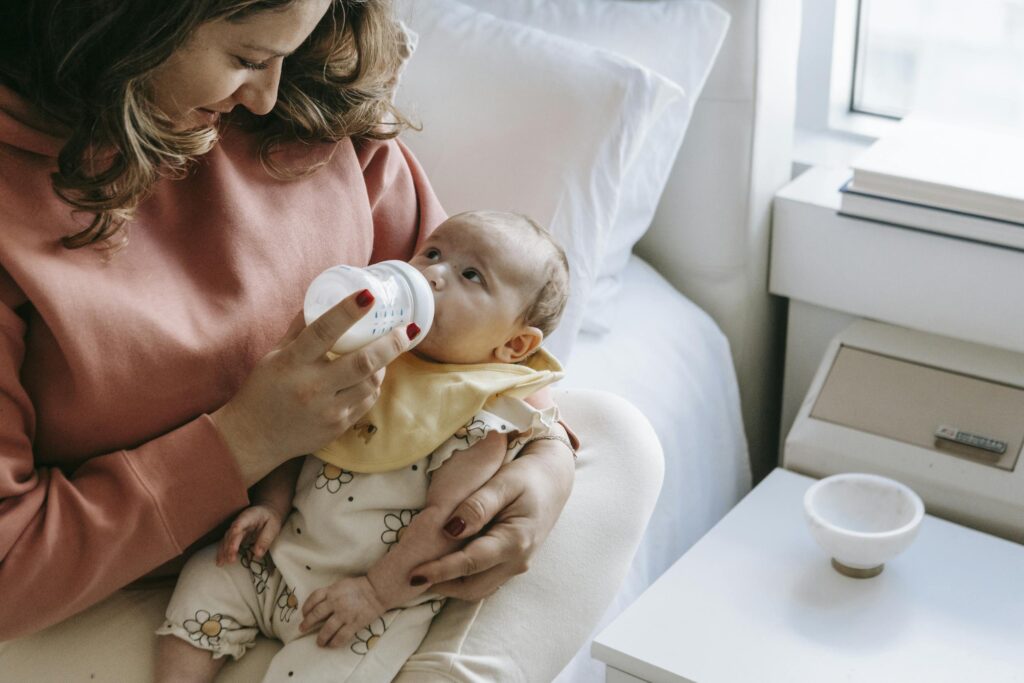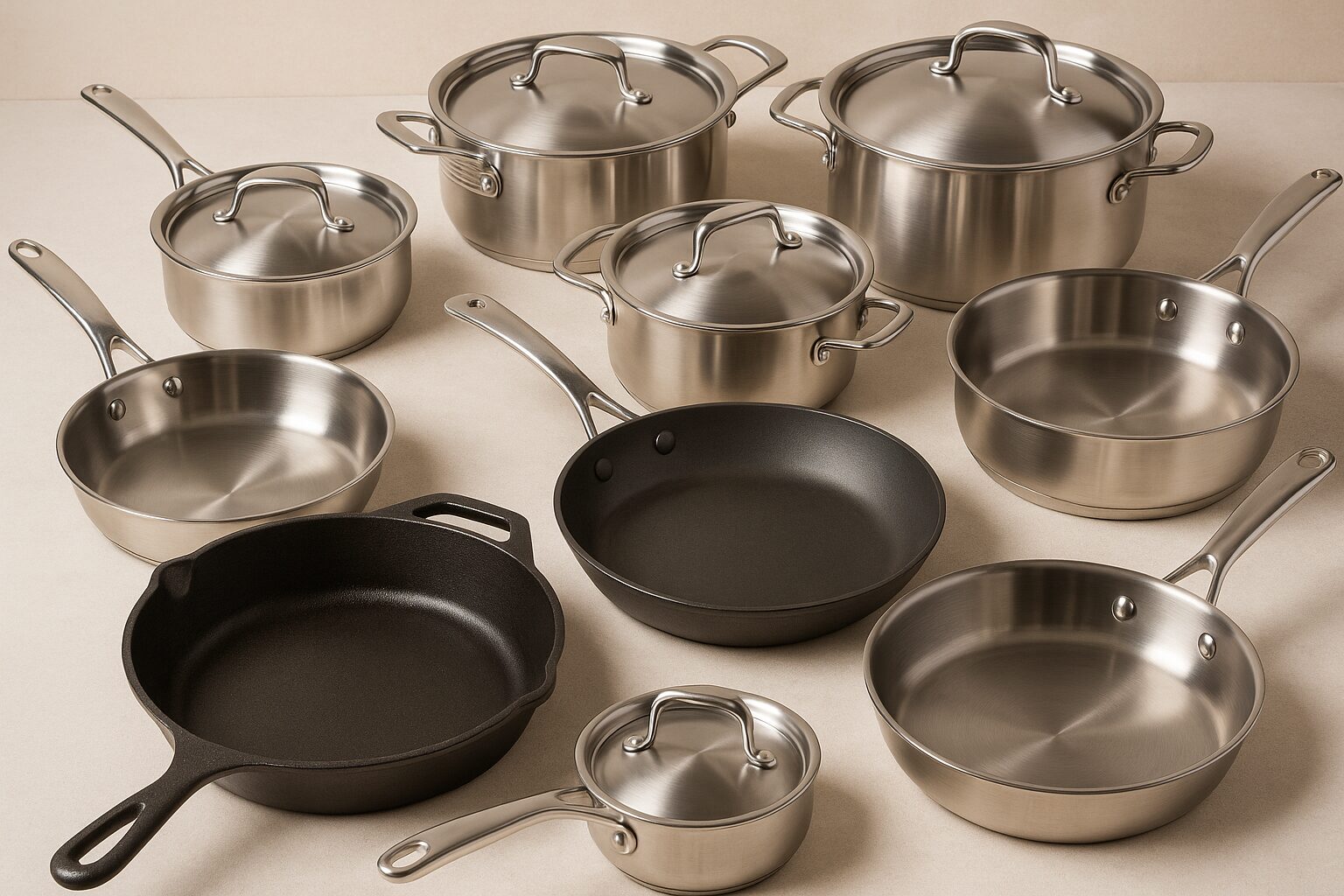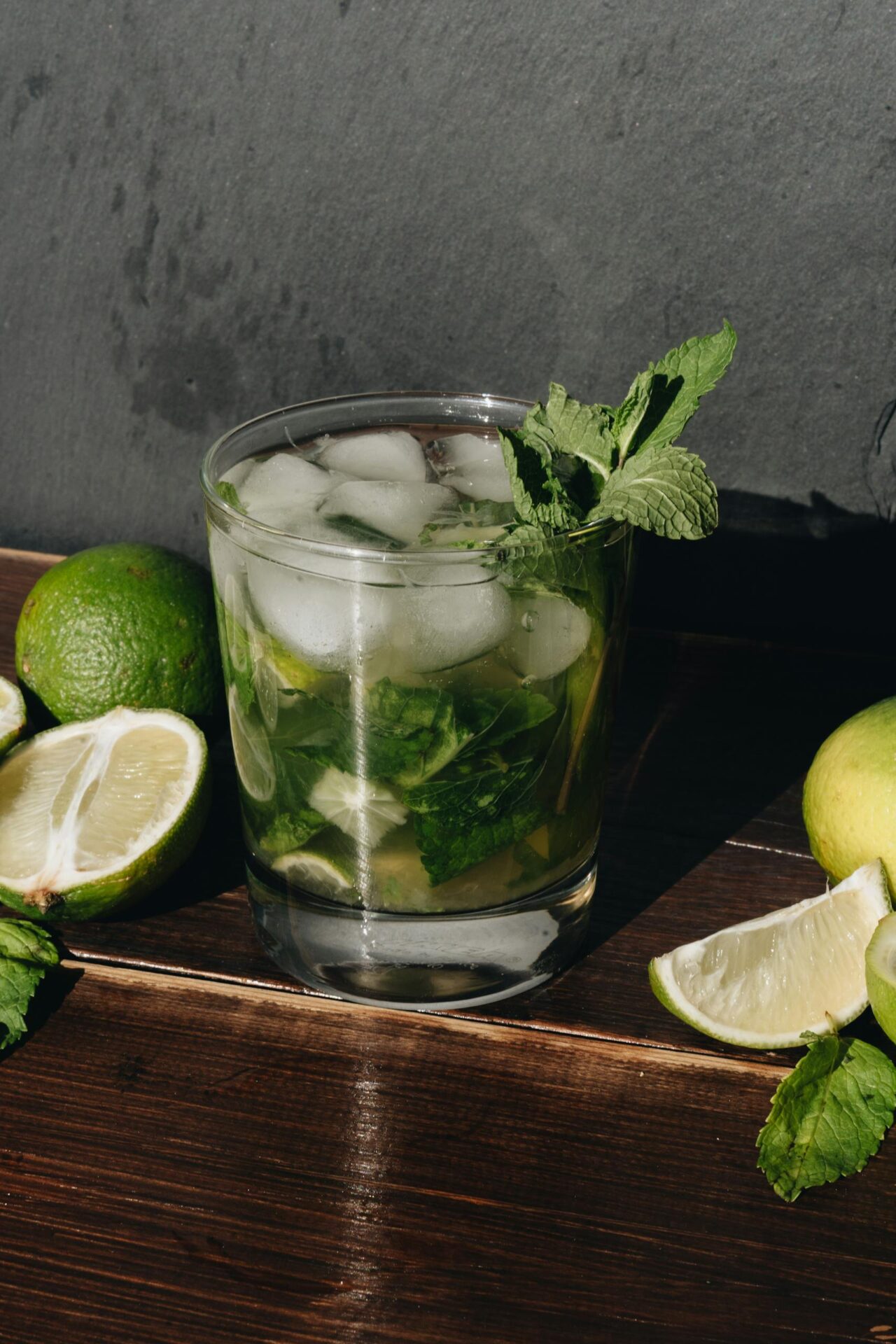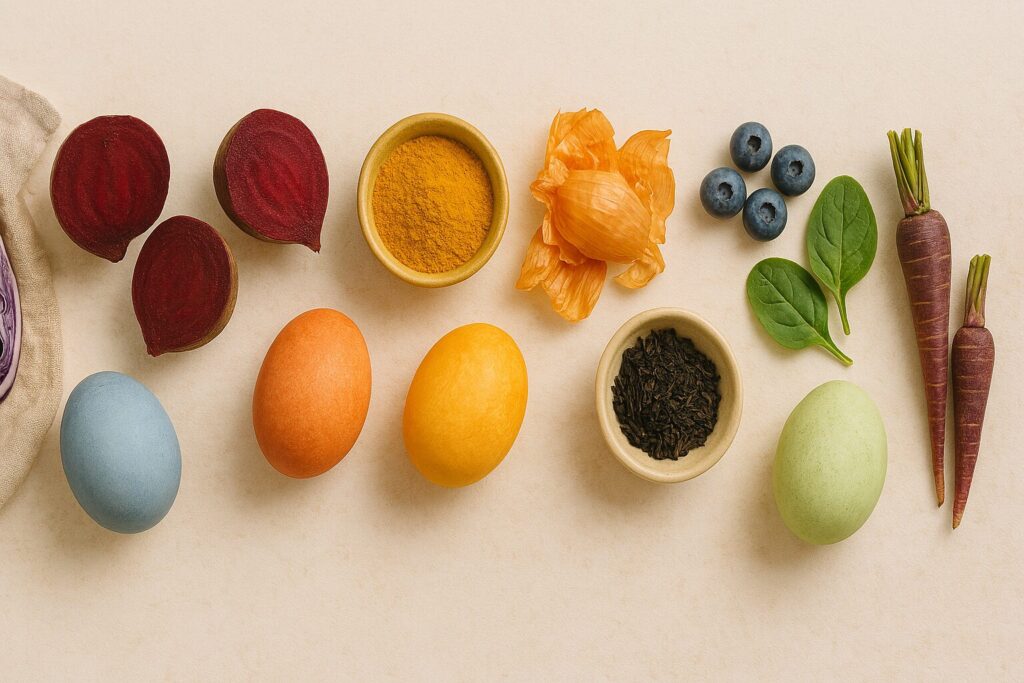
Natural Easter egg dyes are a beautiful, non-toxic alternative to synthetic food coloring—and something I wish I had tried sooner. The first time I dyed eggs with my baby, I reached for blueberries and cabbage instead of a dye kit, and I swear, it felt like a little bit of springtime magic. The colors weren’t just safe—they were stunning.
In this guide, I’ll show you exactly how to dye Easter eggs naturally using real foods you probably already have in your kitchen. Whether you’re looking for a cleaner option for your kids, or you just love a good kitchen experiment, I’ve got you. We’ll go over the best natural egg dye ingredients, step-by-step how-tos, and even safe store-bought kits you can grab on Amazon.
Why Dye Easter Eggs Naturally?
There’s something so satisfying about making your own Easter egg dyes from scratch. But beyond the fun, there are real reasons to ditch the toxic food dyes.
👶 First, it’s safer for little hands.
Most traditional Easter egg dye kits use synthetic food coloring—often derived from petroleum and linked to things like hyperactivity, allergies, and unnecessary chemical exposure. Kids love getting their hands in everything (literally), so using plant-based, non-toxic dyes gives you peace of mind while they get creative.
♻️ It’s also way more eco-friendly.
Natural egg dyeing means no plastic packaging, no artificial ingredients washing down the drain, and way less waste. You can use onion skins, red cabbage, turmeric, and other scraps you might’ve tossed otherwise. It’s a low-waste, high-reward kind of craft.
🌸 And then there’s the beauty of it.
Natural dyes don’t give you those bright, cartoon colors. Instead, you get rich earthy tones—soft blues from cabbage, warm golds from turmeric, rosy pinks from beets. Every egg comes out a little different, which honestly makes them feel even more special.
So yes, dyeing Easter eggs naturally takes a little longer than dropping a tablet in vinegar—but the payoff? Totally worth it.
What You’ll Need to Dye Easter Eggs Naturally
Before you get started, take a peek in your kitchen—you might already have everything you need to make beautiful, non-toxic Easter egg dyes at home.
Natural Dye Ingredients
You can pull rich, earthy colors from fruits, vegetables, and spices. Here’s what works best:
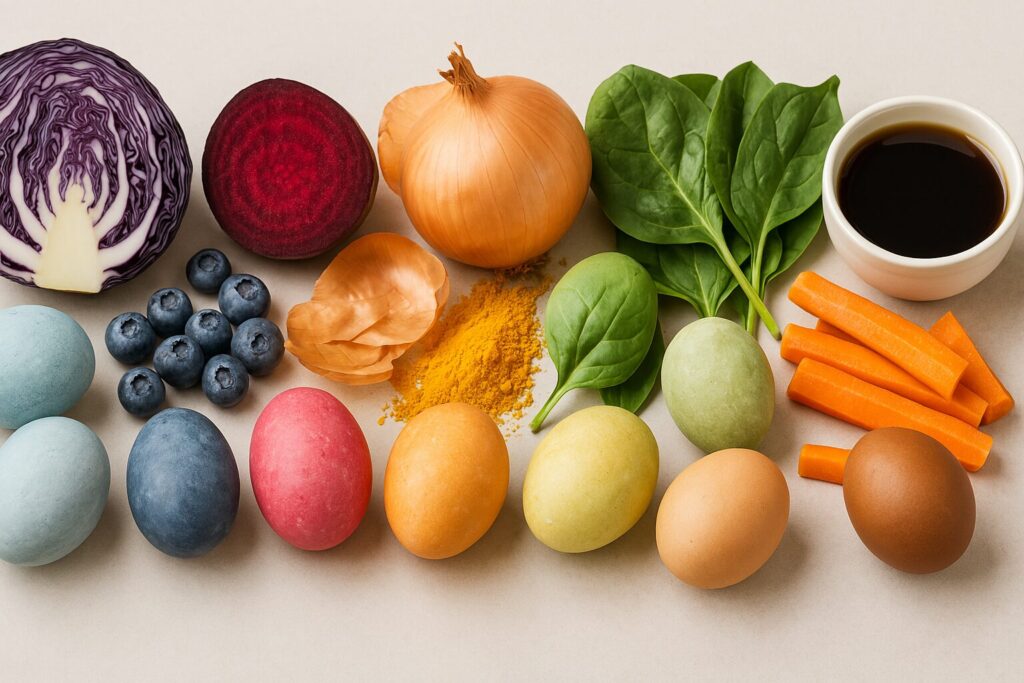
Fruits & Veggies
- Red cabbage → Blue to purple
Yep, red cabbage makes blue! Boil it down and soak your eggs for a few hours (or overnight) for a soft sky blue or deep indigo. Fun fact: on brown eggs, this can lean toward a steely teal or dusty denim. - Beets → Pinks to burgundy
The longer the soak, the deeper the red. Short soaks give you sweet blush pinks, while leaving eggs in overnight creates rich rose or even a rusty maroon—especially on brown eggs. - Onion skins (yellow or red) → Rusty orange, copper, or golden brown
These are Easter dye MVPs. Yellow onion skins make beautiful amber or golden eggs, while red onion skins lean burgundy. This is an old-school Eastern European method that never goes out of style.
Spices
- Turmeric → Bright yellow
Vibrant, cheerful, sunshine yellow. This one stains quickly—5 to 10 minutes might be all you need. Use white eggs for lemony tones, or brown eggs for a warm mustard hue.
Other Natural Ingredients
- Coffee → Light to dark brown
For cozy, rustic tones. Let eggs soak longer for darker espresso shades, or keep it quick for a café au lait color. - Black tea → Beige to tan
More subtle than coffee, but perfect if you’re going for neutral, earthy tones. - Blueberries or purple carrot → Lavender, violet, dusty blue
These give soft, moody shades that feel so dreamy on both white and brown eggs. Expect a little marbling or speckling—part of the charm! - Spinach or parsley → Pale green
This one’s faint but lovely, especially for a nature-inspired egg basket. Try longer soaks and white eggs for best results.
A Note on Egg Color
White eggs will give you brighter, truer colors, while brown eggs result in deeper, more muted tones. I love using both for variety—it makes the basket feel more earthy and natural.
Tools + Supplies
- White and/or brown eggs
- White vinegar – Helps the dye bond to the eggshell.
- Pots or saucepans – For simmering your dye ingredients.
- Strainers or cheesecloth – To remove solids and leave just the dye.
- Bowls, jars, or cups – For soaking the eggs in each color.
- Slotted spoon or tongs – To gently remove eggs without smudging the dye.
That’s it! Once you’ve gathered everything, you’re ready to turn your kitchen into a little Easter egg dye lab.
How to Dye Easter Eggs Naturally (Step-by-Step)
You’ve got your ingredients, you’ve picked your colors—and now it’s time to turn your kitchen into an Easter egg dye station. Whether you’re doing this solo with a warm cup of tea or with a toddler climbing the counter, the process is simple, relaxing, and honestly kind of magical.
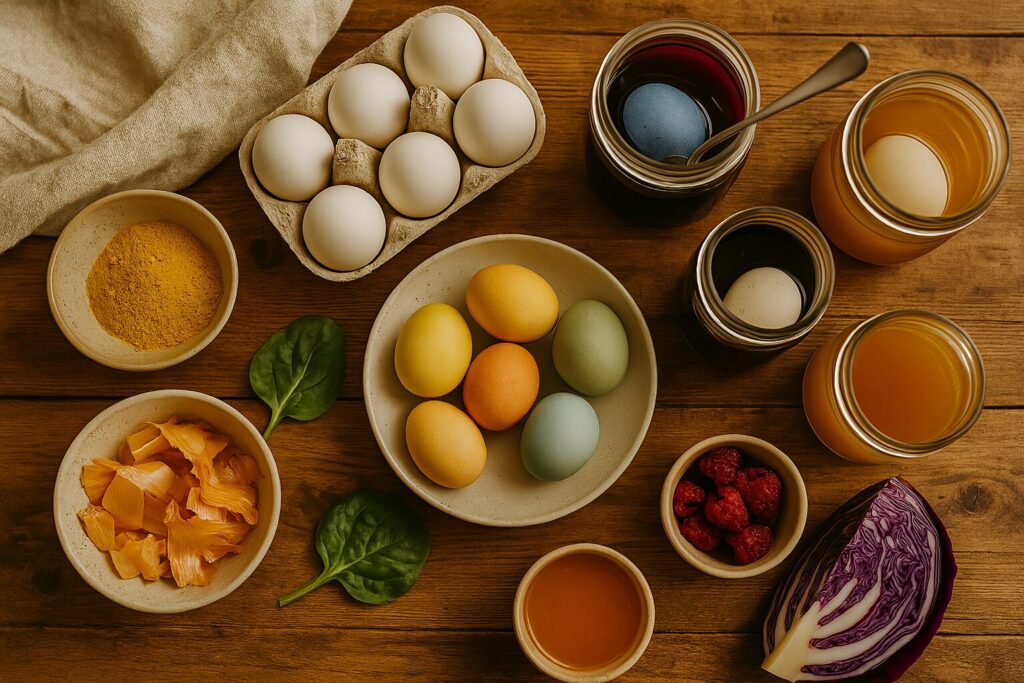
Here’s exactly how to dye Easter eggs naturally using real, food-based ingredients:
Step 1: Prep Your Eggs
Start with clean, hard-boiled eggs. Let them cool completely before dyeing. You can use white or brown eggs—both work beautifully, but the color results will vary (white = brighter pastels, brown = deeper, earthy tones).
Step 2: Make Your Natural Dye
For each color, here’s a simple ratio that works well:
- 1–2 cups chopped fruit/veggie OR 2 tablespoons spice
- 2 cups water
- 1 tablespoon white vinegar (added after cooking)
Bring the ingredient and water to a boil, then lower the heat and simmer for about 20–30 minutes. The water should look richly pigmented (like a strong tea). Once you’re happy with the color, strain out the solids and pour the liquid into a bowl or jar.
Let the dye cool to room temperature, then stir in the vinegar.
Step 3: Soak the Eggs
Place your eggs into the cooled dye. Gently submerge them with a spoon so they’re evenly covered. Then comes the fun part—watching the transformation.
- For pastel shades, soak for 30 minutes to 1 hour.
- For bolder colors, leave them in longer—2 to 4 hours or even overnight in the fridge.
Step 4: Dry + Shine
Once your eggs reach the color you want, lift them out carefully using a slotted spoon or tongs. Pat them dry with a paper towel or set them on a cooling rack or egg carton to air-dry completely.
Want a soft sheen? Rub a tiny bit of oil (like olive or avocado oil) on the eggs once they’re dry. Totally optional, but lovely if you’re going for a more polished, giftable look.
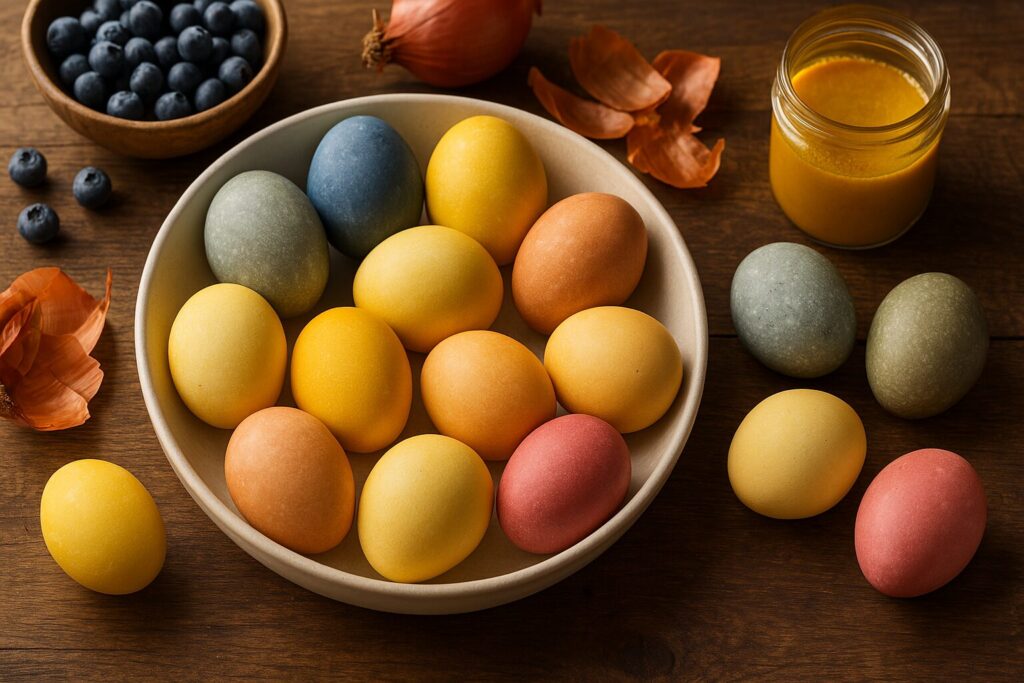
Want a Shortcut? Try These Store-Bought Natural Easter Egg Dyes
Let’s be real: sometimes the idea of slowly simmering cabbage while your toddler shoves blueberries in his face is… not the vibe. That’s where these time saving, non-toxic Easter egg dye kits come in. They’re easy, safe, and just as beautiful—without the mess (or the beet-stained cutting board).
These are my favorite store-bought natural Easter egg dye kits, and yes—they’re available on Amazon.
🌿 Natural Earth Paint Easter Egg Dye Kit
Made from real vegetables and plants—like purple carrots, beets, turmeric, and spinach—this kit gives you four earthy, beautiful shades with zero artificial ingredients. It’s certified non-toxic, compostable, and even the packaging is recyclable.
→ Perfect for families who want something eco-friendly and safe for even the littlest hands.
🐣 Natural Earth Paint + Wooden Egg Kit
Want to skip the hard-boiling altogether? This bundle includes natural dyes plus wooden eggs you can reuse every Easter. No mess, no waste, no fridge space needed.
→ Perfect for keepsakes, crafts, or if your kids just want to paint without eating the results.
🛒 Both of these are available on Amazon with fast shipping—because we both know Easter sneaks up on you.
Creative Tips & Egg Dyeing Techniques to Try
Once you’ve got your natural dyes ready, you can totally keep it simple… or you can turn your eggs into little works of art. Here are some sweet, low-effort ways to level up your natural Easter egg dye game:
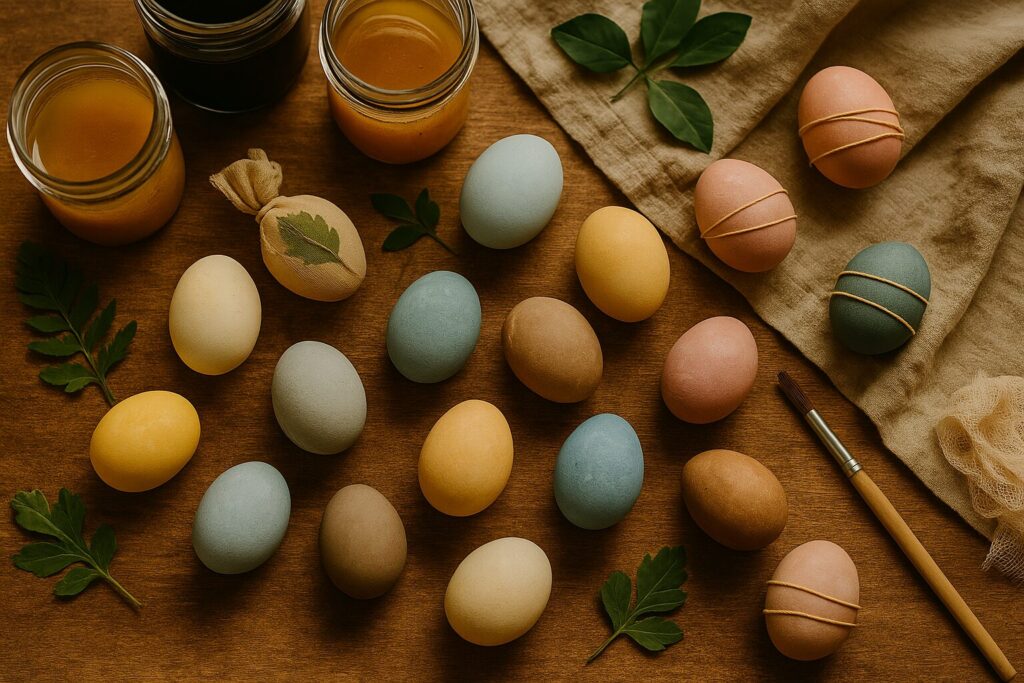
🌿 Try Leaf + Flower Prints
Place a small leaf or flower directly onto the egg (parsley, fern leaves, or baby’s breath work beautifully), then wrap the egg tightly in a piece of cheesecloth and secure it with a twist tie or twine. Soak as usual. When you unwrap it? Instant botanical print.
→ Tip: This works best with lighter dyes and white eggs.
💧 Experiment with Layering Colors
Want green but don’t have spinach? Try yellow turmeric first, let it dry, then soak it in cabbage blue. Boom—layered custom color. This also works for building depth: a quick dip in beet, followed by a longer soak in tea, gives you rosy blush tones with an earthy edge.
🌀 Rubber Band Resist Patterns
Wrap rubber bands around your eggs before dyeing to create cool, abstract patterns. Remove the bands after drying for a striped effect. You can also go full crayon-resist: draw on eggs with white crayon before soaking to reveal sweet little secret designs afterward.
🎨 Go Ombre or Speckled
To get a soft ombre effect, hold just part of the egg in the dye bath at first, then gradually lower it. Or sprinkle salt into the dye while soaking for subtle speckling.
→ These techniques look so pretty in an Easter basket or on a brunch table centerpiece.
✨ Natural Egg Polish
After drying, rub a tiny bit of cooking oil (like olive or avocado) onto each egg with a soft cloth to bring out the richness of the natural dye. It adds a gentle shine and makes them feel finished.
🧺 Mix and Match Egg Types
Using a mix of white and brown eggs adds so much visual interest. The same dye creates different results depending on the shell—white gives pastels, brown gives moody earth tones. Both are beautiful in their own way.
Easter Egg Dyeing Traditions Around the World
There’s something kind of sacred about coloring eggs with your hands. It’s not just about making something pretty—it’s about slowing down, being intentional, and connecting with a tradition that goes way beyond store-bought dye kits.
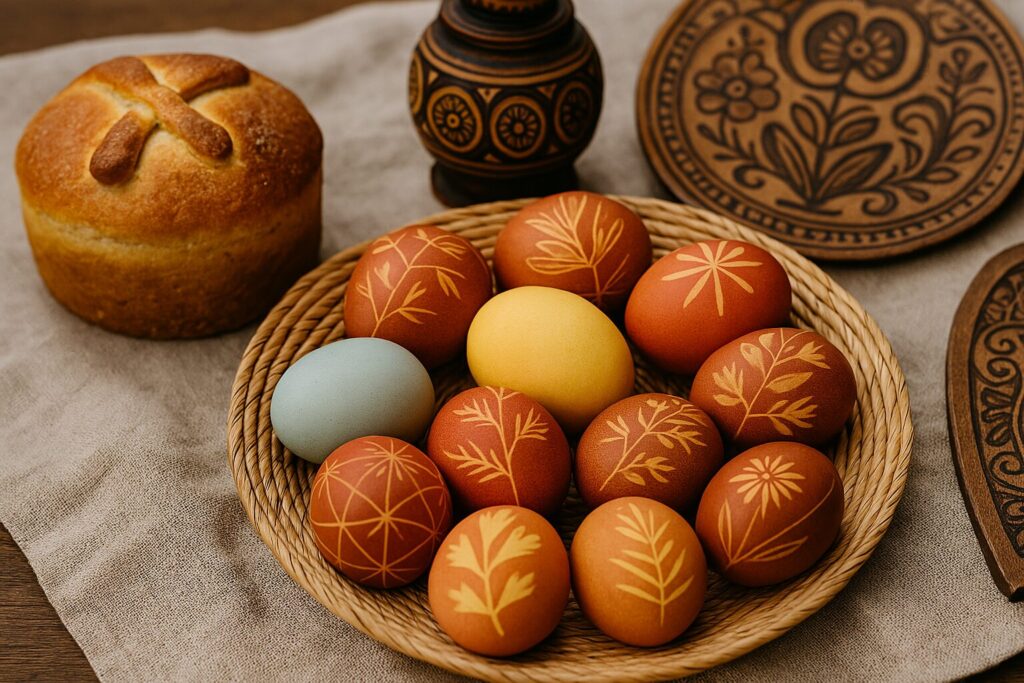
🌎 Around the World
In Eastern Europe, natural Easter egg dyeing has deep roots. For generations, families have used onion skins to create rich amber tones and boiled them with herbs and leaves wrapped around the eggs to make intricate patterns. Ukrainian pysanky—hand-painted eggs using beeswax and dye layers—are probably the most famous, turning each egg into a story told in color and symbol.
In Greece, families dye eggs deep red using onion skins or madder root, symbolizing rebirth and the blood of Christ. The eggs are cracked together at Easter dinner in a game called tsougrisma—whoever’s egg stays intact wins luck for the year.
And in parts of Germany and Austria, eggs are dyed and hung from branches in beautiful Easter trees—a reminder that this tradition has always been about beauty, life, and connection to the natural world.
🌺 Natural Dyeing Inspiration from Hawai‘i
While Easter egg dyeing isn’t native to Hawaiian culture, the islands are rich with plant-based dyeing traditions. Native Hawaiians used plants like ‘ōlena (Hawaiian turmeric), kukui bark, and pōpolo berries to dye kapa (barkcloth) and other woven goods long before synthetic dyes existed.
You can take inspiration from this by using local plants in your dyeing process—maybe try turmeric root from a farmers’ market, red hibiscus, or even a steeped ‘ōlena tea if you’re on the islands. It’s a beautiful way to blend cultures and connect with your local landscape.
🥚 A Tradition Worth Passing On
No matter where you live, dyeing eggs naturally is a gentle way to bring beauty, meaning, and sustainability into your Easter celebration. And when you tell your little ones about the cabbage that turned the egg blue or the onion skins that made copper swirls? You’re passing down more than just a craft—you’re sharing a piece of wonder.
Are Naturally Dyed Eggs Safe to Eat?
The short answer: yes—as long as you follow a few simple guidelines.
Use food-safe ingredients only.
Everything you use to dye your eggs should be edible—think cabbage, beets, turmeric, onion skins, tea, coffee, etc. If you’re using a homemade dye from something in your kitchen, you’re probably in the clear. Just avoid anything moldy, questionable, or not meant to be eaten.
Keep your eggs refrigerated.
After boiling, store your eggs in the fridge and only take them out to dye once everything’s ready. After they’ve soaked and dried, pop them back in the fridge if you plan to eat them later—especially if you’re using them as table décor and it’s warm in your home.
Avoid eating eggs that sat out for hours.
If your dyed eggs were part of a long Easter egg hunt in the sun (or spent a few hours on the counter while everyone admired them), it’s best to compost them instead. You can always save a few “display only” eggs just for decorating and keep the rest food-safe.
Skip the oil finish if you’re planning to eat them.
Rubbing your eggs with oil gives them a lovely, glossy shine—but if you plan to eat them later, it’s best to skip that step or give them a gentle rinse before peeling.

A Sweet, Simple Easter Tradition (With a Natural Twist)
There’s just something so grounding about dyeing Easter eggs naturally. Maybe it’s the quiet rhythm of simmering cabbage on the stove, or the way a plain white egg transforms into this soft little treasure—tinted by plants, spices, and time. It’s slow. It’s intentional. And it’s a whole lot safer than the stuff we grew up with.
For me, the first time I tried natural dyes, I wasn’t sure what to expect. I had a curious baby on one hip, beet juice on my fingers, and zero Pinterest-worthy goals. But when I pulled those eggs from their little dye baths—soft blues, golden yellows, dusty pinks—I felt this spark of joy. They weren’t perfect… they were better. They were real.
Whether you’re all in on the DIY kitchen experiment or leaning on a safe, natural dye kit this year, I hope this guide helped you feel inspired—and maybe a little less overwhelmed. Because this isn’t just about coloring eggs. It’s about creating something beautiful with your kids, for your kids… and avoiding toxic food dyes while you’re at it!
So now I’d love to hear from you! 💛
Did you try the turmeric? Were your cabbage eggs more lavender or blue? What did your little ones think? Leave a comment and tell me how it went—or tag me in your creations. I seriously can’t wait to see the colors you bring to life.
Looking for more non-toxic Easter ideas?
If you’re in full spring mode and want to keep the good vibes going, I’ve got more Easter goodness for you:
- Adorable + Safe Non-Toxic Easter Outfits for Babies + Toddlers
- Eco-Friendly Easter Baskets: Non-Toxic Gift Ideas for Children
From outfits to baskets and everything in between—I’ve got your Easter covered, naturally. 🐣
join the newsletter
Want more non-toxic guides? Subscribe today.

